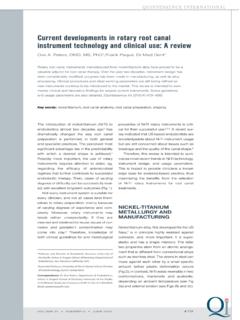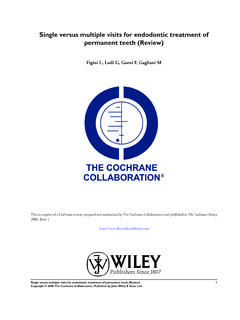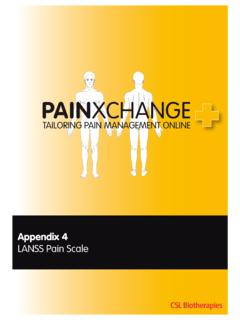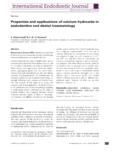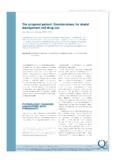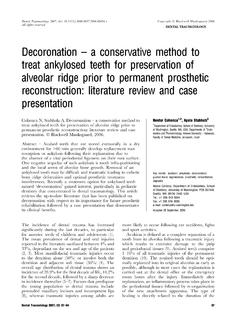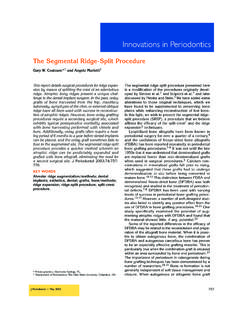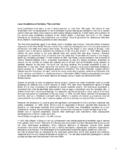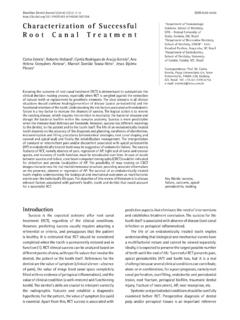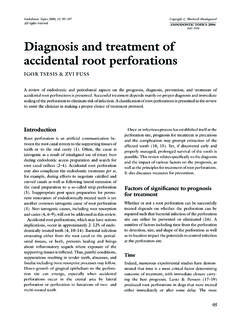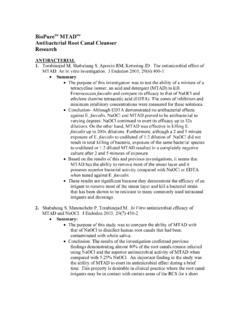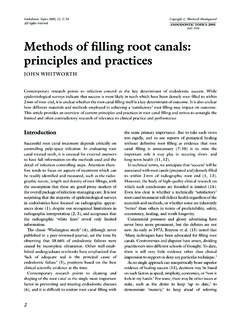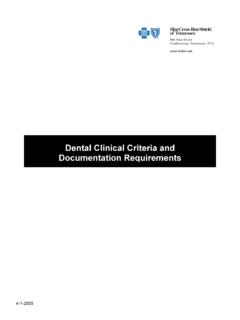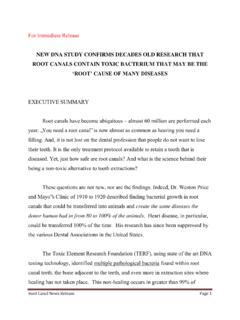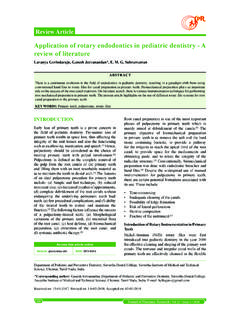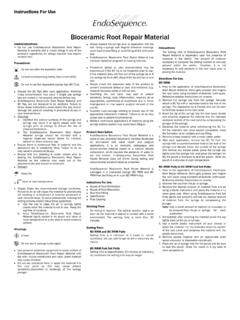Transcription of Cervicalexternalrootresorption invitalteeth B. Van Meerbeek
1 J Clin Periodontol 2002: 29: 580 585 Copyright C Blackwell Munksgaard 2002. Printed in Denmark . All rights reserved 0303-6979. Cervical external root resorption L. Bergmans1, J. Van Cleynenbreugel2, E. Verbeken3, M. Wevers4, in vital teeth B. Van Meerbeek1 and P. Lambrechts1. Departments of 1 Operative Dentistry and X-ray microfocus-tomographical and Dental Materials, BIOMAT, 2 Radiology and Electrical Engineering, ESAT, 3 Morphology histopathological case study and Medical Imaging, 4 Metallurgy and Materials Engineering, MTM, Catholic University of Leuven, Belgium Bergmans L, Van Cleynenbreugel J, Verbeken E, Wevers M, Van Meerbeek B, Lambrechts P. Cervical external root resorption in vital teeth. X-ray microfocus- tomographical and histopathological case study.
2 J Clin Periodontol 2002; 29: 580 . 585. C Munksgaard, 2002. Abstract External resorptions associated with inflammation in marginal tissues present a difficult clinical situation. Many times, lesions are misdiagnosed and confused with caries and internal resorptions. As a result inappropriate treatment is often initiated. This paper provides three-dimensional representations of cervical external resorption, based on X-ray microfocus-tomographical scanning of a case, which Key words: cervical resorption; external root will aid the dental practitioner in recognizing characteristic features during clin- resorption; peripheral inflammatory root ical inspection. In addition, histopathological examination reveals the cellular resorption; tooth resorption; XMCT. morphology of the adjacent tissues.
3 Accepted for publication 21 May 2001. special type of pathological tooth con- pulp tissues and an infected root canal Introduction dition that could be classified in the content (Andreasen 1985). External resorption is a process that group of inflammatory resorptions. In Cervical external resorption occurs leads to an (ir)reversible loss of ce- recent years, several etiologic factors immediately below the epithelial attach- mentum, dentin and bone. It takes have been advocated and some ment of the tooth. As a result, it must place in both vital and pulpless teeth morphological descriptions were made. be noticed that the location is not al- and the identification is mostly made Nevertheless, prediction and prevention ways cervical but related to the level of during routine radiographic or clinical are still impossible and an exact diag- the marginal tissues and the pocket examination as the majority of cases are nosis and treatment is often far from depth.
4 Unless proper treatment is in- asymptomatic. External resorptions easy, depending on the severity and itiated, this type of resorption continues may be physiological or pathological. localization of the defect. and a large irreversible loss of tooth Andreasen suggested an advanced Clinically, cervical external resorp- structure may appear by time. classification in 1985 (Andreasen 1985). tion is associated with inflammation of As mentioned before, the pulp plays Today, his categories of surface, in- the periodontal tissues and does not no role in cervical external resorption flammatory and replacement-ankylosis have any pulpal involvement (Frank & and is mostly normal in these situ- resorption are commonly used. How- Torabinejad 1998). The pulp remains ations.
5 However, a number of cases ob- ever, other investigators have intro- protected by a thin layer of predentin served in recent years have suggested duced subgroups or new categories. until late in the process and it has been that part of this pathology may be as- Consequently, a lack of uniformity in postulated that bacteria in the sulcus sociated with intracoronal bleaching nomenclature is still present, thus con- sustain the inflammatory response in procedures in endodontically treated fusing the dental practitioner. the periodontium (Tronstad 1988, Hei- teeth (Harrington & Natkin 1979). Al- Cervical external resorption, fre- thersay 1999a). This feature differen- though this relationship has not been quently called invasive cervical resorp- tiates cervical external resorption from firmly established by scientific study, tion (Heithersay 1999a) or peripheral another type of inflammatory resorp- strong suspicions exist that bleaching inflammatory root resorption (PIRR) tion called external inflammatory re- agents such as 30% H2O2 were able to (Gold & Hasselgren 1992), presents a sorption, which is continued by necrotic penetrate the dentin from the inside Cervical external root resorption 581.
6 (Rotstein 1991), alter the root surface several etiologic factors and many the- root caries. Caries lesions are rather structure and irritate the periodontal ories have been presented. Other than soft because the organic component of ligament and surrounding tissues systemic and idiopathic forms, this type the dentin has been disintegrated not by (Friedman et al. 1988, Dahlstrom et al. of external resorption in vital teeth can the bacterial acid production but by 1997). In particular, teeth with ce- occur late after orthodontic tooth proteolytic enzymatic degradation. If mentum deficiencies related to previous movement, orthognathic and other the lesion is more apically or proximally trauma (Cvek & Lindvall 1985) or a ce- dentoalveolar surgery, periodontal root situated, it may be detectable by deep mento-enamel disjunction (10%) due to scaling or planing, trauma, bruxism, probing.
7 When the local pocket' is histological variation (Schroeder & fracturing, developmental defects or a probed, copious bleeding and a spongy Scherle 1988) seemed to be at high risk. combination of these predisposing fac- feeling are commonly observed as the This type of cervical resorption, which tors (Cvek 1981, Tronstad 1988, granulation tissue of the resorptive de- is occasionally found after bleaching of Trope & Chivan 1994, Heithersay fect is disturbed. Radiographs may re- a non-vital tooth, is often excessive, as 1999b). It remains to be seen whether veal the lesions once a certain critical it can rapidly progress through the root even vital bleaching in some teeth will dimension has been reached. In a study without being hindered by pulp and result in cervical root resorption at a from Andreasen et al.
8 (1987) conditions predentin. later date. favoring radiographic visibility of cervi- This article will review the clinical As with most external resorptions, cal resorptive defects were a lesion di- and therapeutic concepts associated the cervical root resorptions are usually ameter of greater than mm and the with cervical external resorption in vital painless and go unnoticed by the pa- use of high contrast X-ray technique. teeth. The purpose of the joined case tient unless pulpal or periodontal infec- Cavities located on the proximal surface report is to describe a clinical case of tion supervenes. In addition, a deep re- are more easily detected than those a central incisor with massive external sorptive cavity can result in sensitivity located on the buccal surface.
9 In ad- resorption of cervical crown and root to changes in temperature because of dition, if the site of entry is visible on structure that had to be extracted. It proximity to the pulp. In most cases, the radiograph, the accompanying bone gave us the opportunity to observe the cervical resorptions are detected during resorption may be noticed. In most in- resorptive defect in vivo by standard routine radiographic or clinical exami- stances, the appearance of the crestal and digital radiology and clinical ex- nation. If the lesion is located margin- bone remains unchanged. A compari- amination, and also in vitro by means ally, there may be no external signs, or a son with previously taken radiographs of histological sections and X-ray pink coronal discoloration of the tooth can increase the rate of detection.
10 Fur- microfocus computed tomography crown may be noticed (Fig. 1). The lat- thermore, the use of varying X-ray (XMCT). The outcome of this exami- ter is caused by the translucent appear- angles has been suggested to distinguish nation will be discussed. ance of granulation tissue, which has a internal resorption from external re- deep red color under the overlaying en- sorption and to locate the site of entry amel structure. It bleeds freely on prob- (Seward 1963). Because the pulp in the Pathogenesis, clinical features and ing. By investigating the resorption cav- root canal is not involved in cervical ex- treatment options ity walls with an explorer, a hard, min- ternal resorption, it is usually possible The exact etiology of cervical resorp- eralized tissue sensation will be felt, to clearly distinguish the radiopaque tion is still unknown.
